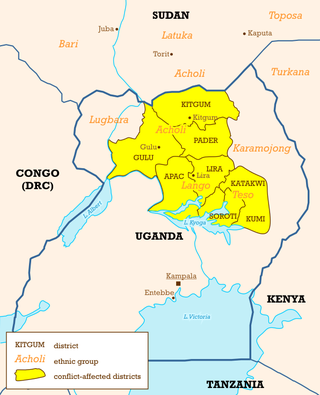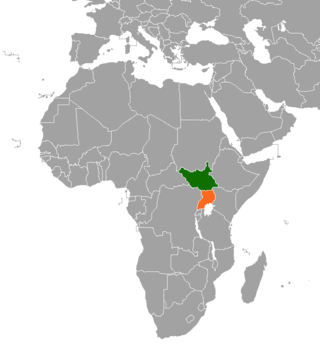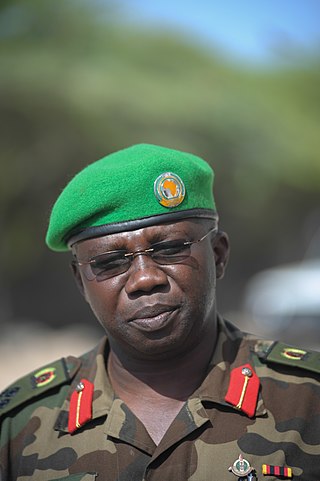Related Research Articles

The Uganda People's Defence Force (UPDF), previously known as the National Resistance Army, is the armed forces of Uganda. From 2007 to 2011, the International Institute for Strategic Studies estimated the UPDF had a total strength of 40,000–45,000, consisting of land forces and an air wing. Recruitment to the forces is done annually.

The Lord's Resistance Army insurgency is a conflict involving the Lord's Resistance Army against the government of Uganda. Following the Ugandan Civil War, militant Joseph Kony formed the Lord's Resistance Army and launched an insurgency against the newly installed President Yoweri Museveni. The stated goal was to establish a Christian state based on the Ten Commandments. Currently, there is low-level LRA activity in eastern areas of the Democratic Republic of the Congo and the Central African Republic. Kony proclaims himself the 'spokesperson' of God and a spirit medium.
Joseph Rao Kony is a Ugandan militant and warlord who founded the Lord's Resistance Army (LRA), designated as a terrorist group by the United Nations Peacekeepers, the European Union, and various other governments including the United Kingdom and United States of America.
Barlonyo is a village in northern Uganda near Lira town, where a number of internally displaced people (IDPs) from parts of northern Uganda lived, as a result of a 20-year LRA insurgency. It is located in Orit Parish, at the North -eastern end of Ogur sub-county in Lira District. It is a 45-minute drive from Lira town.

The start of the period 1994 to 2002 of the Lord's Resistance Army insurgency in northern Uganda saw the conflict intensifying due to Sudanese support to the rebels. There was a peak of bloodshed in the mid-1990s and then a gradual subsiding of the conflict. Violence was renewed beginning with the offensive by the Uganda People's Defence Force in 2002.
The period from 2000 to 2006 of the Lord's Resistance Army insurgency in northern Uganda begins with the assault of the Uganda People's Defence Force (UPDF) upon LRA strongholds in South Sudan. This in turn led to a series of retaliatory attacks by the Lord's Resistance Army of an intensity not seen to since the mid-1990s. International awareness of the conflict gradually grew and in September 2005, the International Criminal Court issues warrants for the arrest of senior LRA commanders, including Joseph Kony.
The Aboke abductions were the kidnapping of 139 secondary school female students from St. Mary's College Secondary school by rebels of the Lord's Resistance Army (LRA) on 10 October 1996, in Aboke, Kole District, Uganda. The deputy head mistress of the college, Sister Rachele Fassera of Italy, pursued the rebels and successfully negotiated the release of 109 of the girls. The Aboke abductions and Fassera's dramatic actions drew international attention, unprecedented at that time, to the insurgency in northern Uganda. A book titled "Aboke Girls" was written by Els De Temmerman about the abductions and effects of the abductions.
Aboke is a town in the Kole District of the Northern Region of Uganda. It was the location of the Aboke abductions in October 1996.

The Juba talks were a series of negotiations between the government of Uganda and the Lord's Resistance Army rebel group over the terms of a ceasefire and possible peace agreement. The talks, held in Juba, the capital of autonomous Southern Sudan, began in July 2006 and were mediated by Riek Machar, the Vice President of Southern Sudan. The talks, which had resulted in a ceasefire by September 2006, were described as the best chance ever for a negotiated settlement to the 20-year-old war. However, LRA leader Joseph Kony refused to sign the peace agreement in April 2008. Two months later, the LRA carried out an attack on a Southern Sudanese town, prompting the Government of Southern Sudan to officially withdraw from their mediation role.
The Atiak massacre occurred on April 20, 1995, when a group of estimated 300 Lord's Resistance Army soldiers led by Vincent Otti entered the northern Ugandan town of Atiak, Amuru District. After routing the UPDF and rounding up hundreds of civilians, the LRA announced, "you Acholi have refused to support us. We shall now teach you a lesson." The LRA then handpicked young boys and young girls from the rest, in order to conscript into their ranks and to use as sex slaves, and marched them into the bush. Most of the remaining 200–300 captives were executed by gunfire.

The Lord's Resistance Army (LRA) is a Christian extremist organization operating in Central Africa and East Africa. Its origins were in the Ugandan insurgency (1986–1994) against President Yoweri Museveni, during which Joseph Kony founded the LRA in 1987.
The 2008–2009 Garamba offensive started on 14 December 2008, when joint Ugandan, DR Congolese and Southern Sudanese forces launched a botched military attack against the Lord's Resistance Army (LRA) in the Garamba region of DR Congo.

South Sudan and Uganda are neighboring states with strong cultural economic and political ties. The South Sudan and the neighbouring state of Uganda enjoy relatively strong cultural, political, and economic ties. As South Sudan neared independence, both states begun to take advantage of increased opportunities for trade, development and educational exchanges. The rebel group Lord's Resistance Army (LRA), however, continues to operate in the border areas between South Sudan, the Democratic Republic of Congo and Uganda.

The International Criminal Court investigation in Uganda or the situation in Uganda is an ongoing investigation by the International Criminal Court (ICC) into the Lord's Resistance Army insurgency which has been taking place in northern Uganda and neighbouring regions since 1987. The Lord's Resistance Army is a Christian-based group led by Joseph Kony that is accused of numerous human rights violations and war crimes including massacres, the abduction of civilians, the use of child soldiers, sexual enslavement, torture, and pillaging. After the government of Uganda referred the matter to the ICC in December 2003, warrants of arrest were issued in 2005 for Joseph Kony, Raska Lukwiya, Okot Odhiambo, Dominic Ongwen, and Vincent Otti, who became the first people to be indicted by the Court.

Major General Richard Prit Olum, commonly known as Dick Olum, is a military officer in the Uganda People's Defence Force (UPDF). Effective 13 May 2024, he serves as commander of the "South Sudan Stabilization Mechanism", an observer force to ensure adherence to the peace agreements. Before that, he served as the Ugandan commander of the UPDF forces in the Democratic Republic of the Congo under the joint Uganda/DRC mission code named Operation Shujaa. He simultaneously served as the commander of the UPDF Mountain Division, based in Fort Portal, Kabarole District at the base of the Rwenzori Mountains. His appointment was made on 12 October 2022.
The following lists events that happened during 2005 in Uganda.
The Regional Cooperation Initiative for the elimination of the LRA (RCI-LRA) with its military arm, the African Union Regional Task Force was a multi-national operation to counter the Lord's Resistance Army (LRA). On 22 November 2011 the AU Peace and Security Council authorized the RCI-LRA with the mandate to "strengthen the operational capabilities of the countries affected by the atrocities of the LRA, create an environment conducive to the stabilization of the affected areas, free of LRA atrocities, and facilitate the delivery of humanitarian aid to affected areas." The United Nations provided logistical support, the European Union and African Union contributed additional funding, and the United States provided non-combat military and strategic support.

Major General Richard Otto is a senior military officer in the Uganda People's Defence Forces (UPDF). Since 13 May 2024, he has been the Commander of the UPDF Mountain Division and also Commander of "Operation Shujaa", a joint undertaking by the UPDF and the Armed Forces of the Democratic Republic of the Congo (FARDC) to neutralize the Allied Democratic Front (ADF) terrorist organization in the Eastern DR Congo. Immediately prior to his current assignment, Richard Otto was the chairman of the "South Sudan Peace Mechanism", an IGAD-sponsored observer mechanism, to ensure adherence to the peace treaties by the protagonists.

The Acholi people are a Nilotic ethnic group of Luo peoples, found in Magwi County in South Sudan and Northern Uganda, including the districts of Agago, Amuru, Gulu, Kitgum, Nwoya, Lamwo, Pader and Omoro District. The Acholi were estimated to number 2.3 million people and over 45,000 more were living in South Sudan in 2000.

From 1986 to 1994, a variety of rebel groups waged a civil war against the Ugandan government of President Yoweri Museveni. Most of the fighting took place in the country's north and east, although the western and central regions were also affected. The most important insurgent factions were the Uganda People's Democratic Army (UPDA), the Uganda People's Army (UPA), Alice Auma's Holy Spirit Movement (HSM), and Joseph Kony's army. Several smaller rebel factions and splinter groups of the larger movements waged their own campaigns; the rebels often clashed with each other. All belligerents, including the government, targeted civilians and committed human rights violations. In course of fighting that involved tens of thousands of troops, the Ugandan government was able to gradually defeat or contain most rebel factions. The operations in the north and east caused great destruction and resulted in high civilian casualties.
References
- ↑ "Health and mortality survey" (PDF). Retrieved 20 April 2013.
- ↑ "The secret genocide" . Retrieved 20 April 2013.
- ↑ "Petition, Item in KAA" (PDF). Retrieved 18 April 2013.
- ↑ "A detailed atrocities caused in the Acholi sub-region" . Retrieved 3 April 2013.
- ↑ "Wars, concentration camps and strange nodding disease striking Northern Uganda" . Retrieved 3 April 2013.
- ↑ "A Genocide in Northern Uganda? 'The Protected Camps'" . Retrieved 3 April 2013.
- ↑ "IDPs in Northern Uganda" . Retrieved 7 June 2019.
- ↑ "Uganda interview with Radhika Coomaraswamy" . Retrieved 3 April 2013.
- ↑ "Uganda ends hunt for LRA" . Retrieved 7 June 2019.
- ↑ "Uganda, need to focus on returnees and remaining IDPs" . Retrieved 20 April 2013.
- ↑ "Amuru Land Grab" . Retrieved 7 June 2019.
- ↑ "Land Grabbing" . Retrieved 7 June 2019.